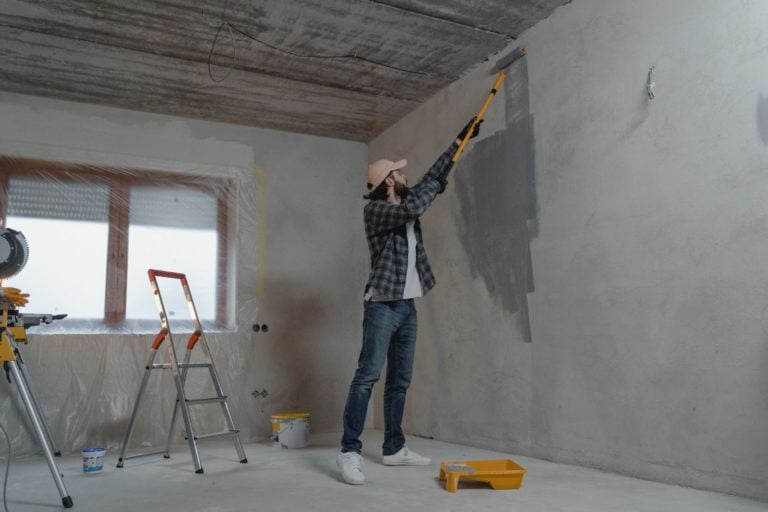The right facility management software helps you track work, plan ahead, and keep operations running smoothly.
When facility management runs well, no one notices. But when a work order gets lost or a system breaks down, problems can pile up pretty fast.
Juggling sudden issues, routine maintenance, and incoming requests is a lot to handle for any facilities team.
The right facility management software calms the chaos and helps you set clear priorities, respond faster, and turn scattered tasks into steady workflows.
In this article, I looked at the 6 best facility management software, including:
- Connecteam
- UpKeep
- FMX
- eMaint CMMS
- Limble CMMS
- AkitaBox
Our Top Picks
-
1
Best all-in-one Facility Management Software
-
2

Good for mobile-first work order and asset management
-
3
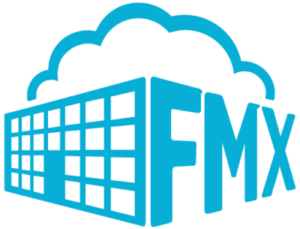
Good for facilities, maintenance, and scheduling across multiple sites
Why trust us?
Our team of unbiased software reviewers follows strict editorial guidelines, and our methodology is clear and open to everyone.
See our complete methodology
What to Look For in a Facility Management Software Tool
Here are the key features I looked for to help find the best facility management software:
Must-have features
- Work order management: The software should let teams easily create, assign, and track word orders so nothing gets lost.
- Asset tracking: You should be able to view each asset’s details, including repair history, performance, and warranty info.
- Maintenance scheduling: The tool must support recurring tasks, reminders, and schedules to stay ahead of breakdowns.
- Checklists and forms: Managers need to be able to build detailed checklists and forms for inspections, audits, and safety checks.
- Task management: You should be able to assign tasks, set priorities, and track progress.
- Ticketing system: The software should turn employee or tenant requests into trackable tickets right away.
I also made sure the software is:
- Mobile accessible, so facility managers can access the tools they need from anywhere.
- Easy to use, so teams can use the software without a steep learning curve.
Finally, I checked for these features that simplify facility management:
- Document storage for quick access user manuals, SOPs, and floor plans.
- Real-time messaging to keep everyone in the loop without switching apps.
- Integrations that seamlessly connect with access control, sensors, and other systems.
The 6 Best Facility Management Software Tools of 2025
-
Connecteam — Best all-in-one Facility Management Software
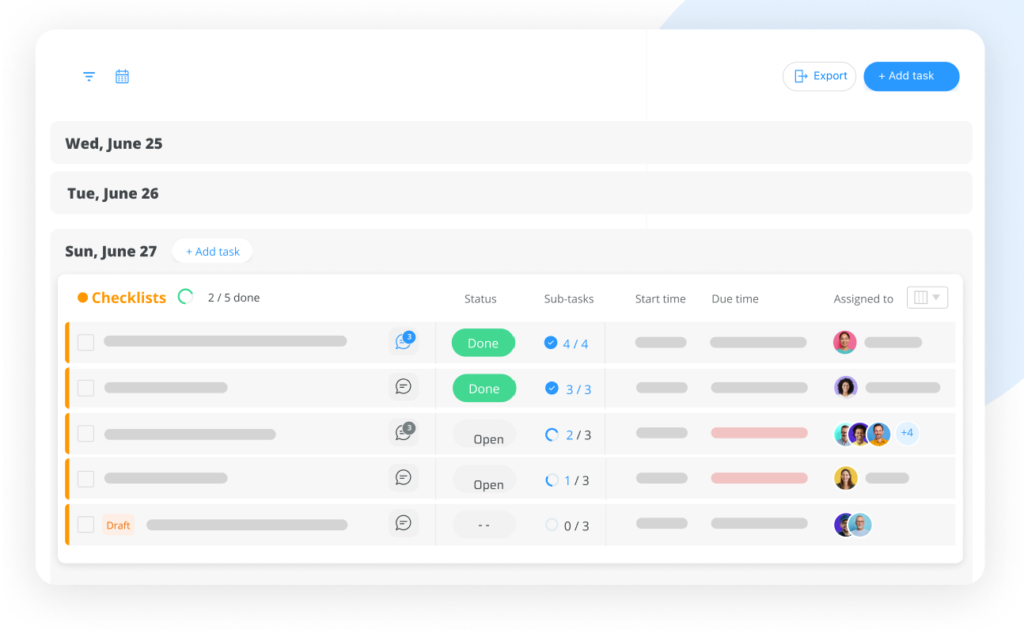

Connecteam is an all-in-one facility management software designed to simplify work for maintenance teams. It brings together ticketing, work order management, task tracking, scheduling, and more into one app.
Here’s how Connecteam makes a difference:
Why I chose Connecteam: Connecteam is built for teams who work on the go. It has all the tools you need to manage your operations, communications, and people in one app.
Schedule and track time
I really liked using Connecteam’s job scheduling tools. You can build templates, set recurring shifts, and assign technicians to specific tasks or locations right from the schedule. It’s especially helpful for routine work. Any updates you make reflect in real-time, and teams can check the schedule from their phones.
Technicians can use the employee time clock, with GPS tracking if you need to confirm where a job starts and ends. It’s an easy way to log hours accurately without chasing down timesheets. All hours are automatically recorded into digital timesheets for payroll.
Track tasks
Connecteam’s employee task tracking makes it easy to create, assign, and manage tasks from start to finish. I liked that you can delegate tasks to one person or an entire team and include due dates, instructions, checklists, files, photos, and even location details. You can also break larger projects into subtasks and set recurring tasks for routine work, preventative maintenance, or equipment checks.
Each task’s status updates automatically, so managers always know what’s open, in progress, complete, or overdue. When someone changes the status, managers and tagged team members see it in real-time.
I also liked that team members can comment directly inside the task, keeping questions and discussion in one place. And the best part is that teams can access everything from their phones, letting them track their work wherever they go.
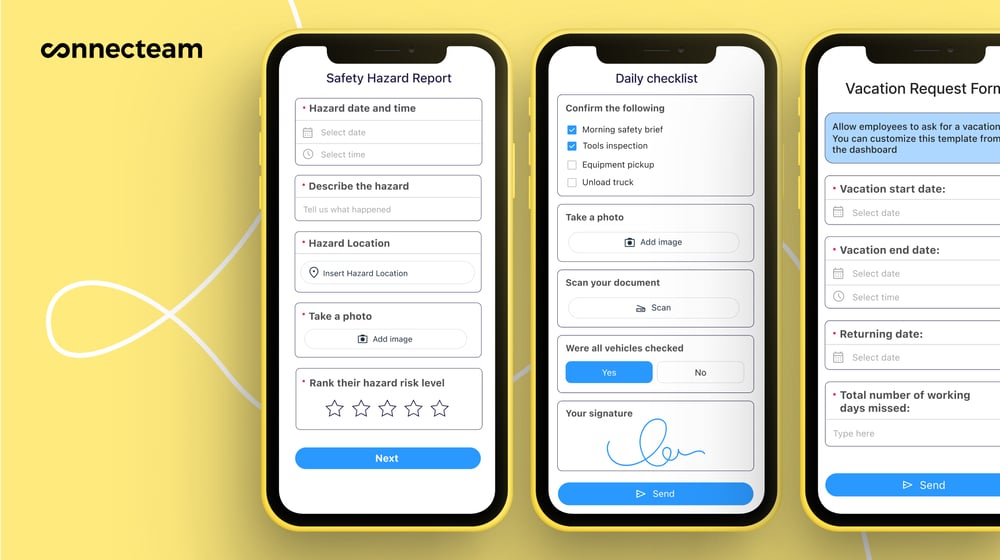
Create forms and checklists
Connecteam’s digital forms and checklists are a great upgrade from paper work orders. You can build forms from scratch or start with a template and adjust it to fit your facility’s needs.
If you already have a format you like, you can upload or take a picture of it and Connecteam’s AI will instantly convert it into a structured digital version. I loved this because it lets you keep the work order style you already use, just without filling it out by hand every time.
What impressed me most was how flexible the field types are. Along with the standard text, dropdowns, and multiple choice, Connecteam also offers speech-to-text, which uses AI to capture, summarize, and sort inputs. I thought this was a smart, hands-free way for teams to record details quickly and accurately.
You can also attach files, scan documents, and add photos. Every form is time-stamped and stored in the app, so it’s easy to track submissions and find what you need later. Plus, the reporting tools help you see what’s getting done, how fast, and where things might be slowing down. It’s a useful way to catch patterns early and make smarter decisions moving forward.
Handle tickets effectively
With Connecteam’s internal help desk, facility teams can turn scattered requests into a structured, consistent process. I liked that you can create a dedicated facilities desk where anyone in the organization can submit maintenance requests, report issues, or ask questions. Employees can submit tickets through the mobile app using Connecteam’s chat, and all requests go to one central hub that the entire facilities team can review, assign, and track.
What really stood out to me was the level of visibility managers get. They can clearly follow every ticket from submission to resolution, monitor response times, and make sure nothing gets missed. It adds order and accountability to the process, while giving employees an easy way to reach the facilities team without relying on random messages.
Stay connected
Connecteam’s team instant messaging keeps your crew’s communication in one place. Managers can create group chats or message team members directly, and the layout feels familiar, which makes it simple for everyone to use.
I liked that messages are completely searchable, so you can easily find past conversations or important details. You can send files, images, videos, and links directly in the chat, and tag specific team members when something needs quick attention. Managers can also enable push notifications, so employees receive mobile alerts instantly.
Connecteam’s built-in employee directory is a clean alternative to saving work contacts on your personal phone. Employees can find anyone by name, crew, role, or location, and start a chat instantly. You can also add external contacts, like subcontractors, vendors, or suppliers, giving your crews quick access to the people they work with regularly.
Integrations
Connecteam has an API integration and syncs with the tools you already use, including:
And so much more…
Connecteam is a powerful platform with even more tools to support your facility operations. Store and organize staff documents like contracts, certifications, licenses, and tax forms, and receive reminders about expiration dates. Upload guides, manuals, SOPs, and other resources to the company knowledge base, and ask the built-in AI agent for instant answers. Use the AI Course Creator to build custom training and onboarding materials in minutes, and get employees up to speed quickly. Connecteam brings all these tools together to help you manage your day-to-day work.
Connecteam also offers a free for life plan – Get Started Now!
Key Features
- Task management
- Job scheduling
- Forms and checklists
- Help desk ticketing
- Built-in team chat
- Company directory
Pros
- All-in-one solution
- Mobile accessible
- Easy-to-use
- Free plan for small teams
Cons
- More integrations still in development
Pricing
Free-for-life plan availablePremium plans start at $29/month for 30 users
14-day free trial, no credit card required
Start your free trial -

UpKeep — Good for mobile-first work order and asset management

UpKeep is a CMMS platform that helps facility teams organize work orders, track assets, and plan ahead of equipment failures.
Why I chose UpKeep: I liked UpKeep’s strong mobile app and clean interface because it felt like any team could use them, no matter their tech background.
Work orders and requests
Creating, assigning, and tracking work orders with UpKeep was pretty straightforward. You can access them from the desktop or mobile app and set priorities and due dates, add files or photos, and filter tasks by location, technician, status, or urgency. I liked that there are shared work orders, which lets you collaborate across teams or with external contractors. There’s also built-in time tracking, so team members can record how many hours they spend on each task.
For more detailed instructions, you can attach checklists to work orders, which I can see being helpful for recurring tasks.
I also liked UpKeep’s Request Portal, which gives your organization a simple way to submit maintenance needs. You can create portals for general requests, specific locations, or individual assets, and anyone can access them through a QR code without logging in. Requests are automatically routed and converted into work orders, and updated in real-time. The only drawback is that the Request Portal is limited to higher-tier plans, which could be a barrier for smaller teams.
Assets tracking and preventive maintenance
UpKeep gives each asset a profile page, which includes details like name, location, type, and assigned team or user. You can also view the asset’s work order history, linked parts, manuals, meter readings, and sensor data (if you use UpKeep Edge for remote monitoring). I liked that you can assign each asset a QR code for mobile access in the field. Like the Request Portal, advanced features like reliability tracking and asset check-in/out are also limited to higher-tier plans.
I thought that UpKeep’s preventive maintenance (PM) tools were pretty flexible. You can schedule PM by date, condition, meter readings, or a combination of each. Plus, the platform supports detailed timing controls, recurring tasks, and multiple schedules for one asset. I liked that this works for equipment that needs specific types of upkeep at different intervals.
Reporting and automation
UpKeep’s reporting tools give you visibility into operational trends, costs, completion rates, and recurring problems. I liked that the dashboards were easy to read, so anyone could understand and use the data.
When it comes to UpKeep’s AI, it seems like a newer addition to the platform. That said, I was impressed by being able to generate work order summaries and having suggested PM tasks. I also liked building automated workflows to assign tasks and send alerts for overdue work.
My favorite automation was the Smart Scheduler, which recommends the best technician for a job based on availability, priority, and location. But like with many of UpKeep’s features, this is also locked behind higher-priced plans.
What users say about UpKeep
I really like how simple it is for staff to submit work orders — especially through the mobile app. They can attach photos, describe the issue, and I can assign it immediately. It saves me from chasing emails or paper notes.
I don’t like that there is limited customization, higher costs for advanced features, and limited automations in free or lower-tier plans.
Key Features
- Work orders
- Preventive maintenance
- Asset tracking
- Checklists
Pros
- Intuitive interface
- Mobile app
Cons
- Some tools only available at higher tier plans
- Expensive per-user pricing
Pricing
Starts at $20 per month per user Trial: Yes — 7 days Free Plan: No
-

FMX — Good for facilities, maintenance, and scheduling across multiple sites
Available on
- Web
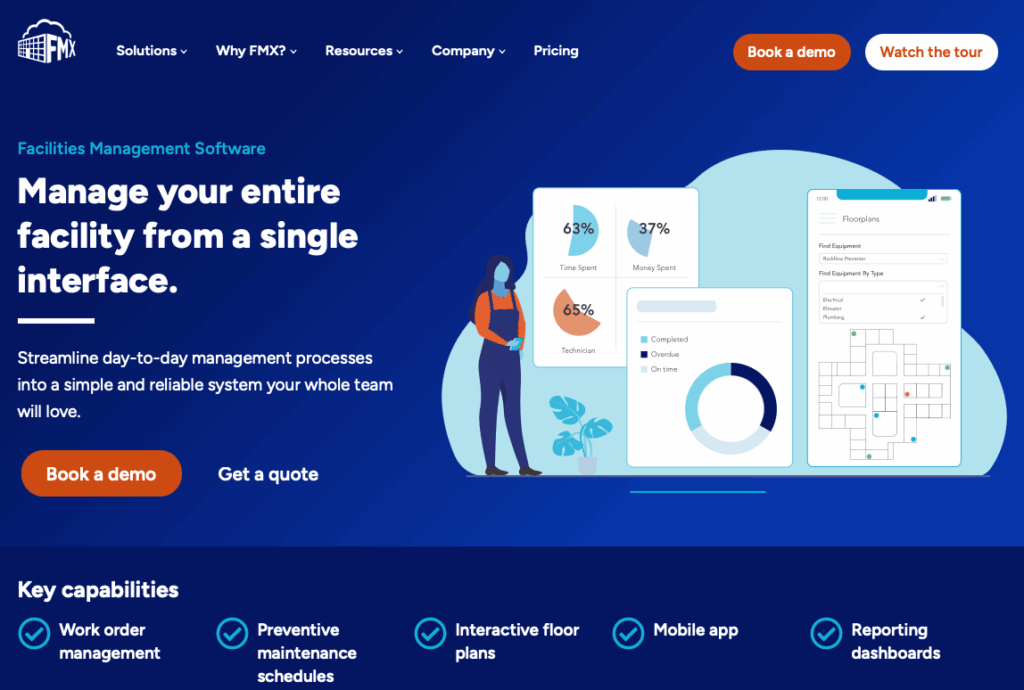
FMX is a facility management platform that helps teams manage work orders, preventive maintenance, and facility operations.
Why I chose FMX: I chose FMX because of its calendar-focused design and ability to create custom workflows.
Work order and request management
I liked how FMX makes it easy to manage maintenance requests by converting every submission into a trackable work order. Each request receives a unique ID and includes key details, including location, equipment, due date, and a description of the issue. I really liked the “followers” feature, which works like CC’ing someone on an email. If someone is added as a follower, they get automatic updates, so key personnel stay informed without the extra effort.
Managers can create custom fields to collect the exact information they need, and users can upload photos, diagrams, or documents to give technicians more context. You can also submit a request on behalf of someone else. FMX provides shortcuts to create requests directly from the calendar, and there’s a bulk import feature if you need to add multiple requests at once.
Scheduling and calendar integration
FMX really stands out when it comes to its integrated calendar. It acts like a central hub for all facility activities, not just maintenance. You can manage preventive maintenance, one-off work orders, room or facility rentals, office hoteling, and event setups in one view. I liked how the preventive maintenance scheduling supports both time-based and meter-based triggers.
While powerful, I found it a bit overwhelming to have so much information displayed at once on the calendar. Every activity type is color-coded and there are filters to view by location, department, task type, and assigned worker. But even with these options, I still thought the monthly view was a lot to take in. I also wasn’t a fan of the agenda view, which felt more like a minimal list than a helpful overview.
Workflows and reporting
FMX offers strong customization options that help you adjust the platform to fit your workflows. You can build multi-step approval chains for work requests and set rules that automatically assign tasks based on skills, workload, or location. FMX also offers asset and inventory management, which lets you link equipment to work orders and track the parts used.
In terms of reporting, FMX’s dashboards show you request volume, track team performance, and maintenance costs by location or category. You can configure them to highlight the KPIs that matter most to your team. I can see these analytics making it easier to allocate resources, plan ahead, and spot recurring issues early on.
Key Features
- Work orders
- Request management
- Asset and inventory tracking
- Reporting dashboards
Pros
- Customizable workflows
- Mobile accessible
Cons
- Complex calendar view
- Pricing not publicly available
Pricing
Contact vendor for price Trial: No Free Plan: No
-

eMaint CMMS — Good for asset tracking and maintenance history
Available on
- Web
- iOS
- Android
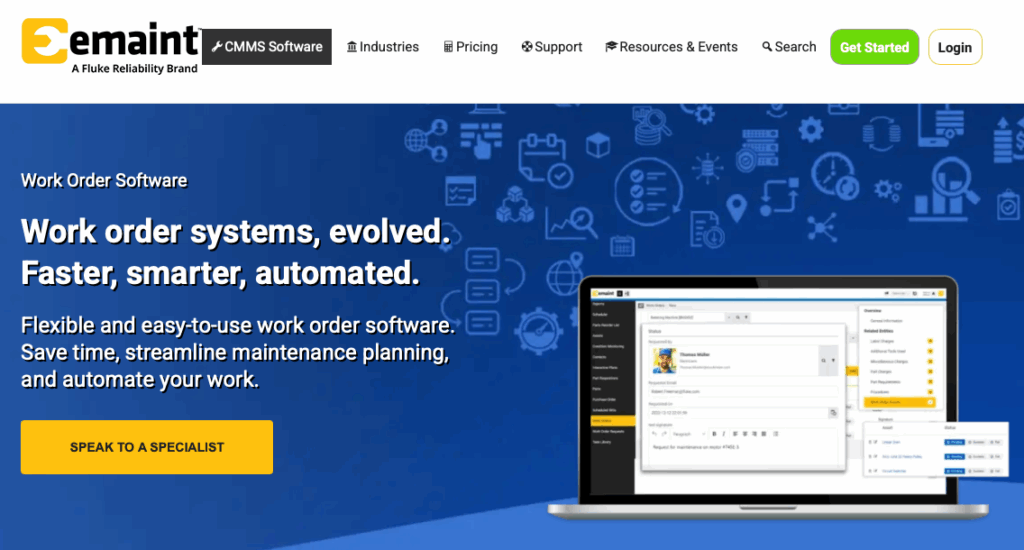
eMaint is a CMMS by Fluke Reliability, built for enterprises and large organizations. It offers solutions for work orders, preventive maintenance, asset management, inventory, and purchasing.
Why I chose eMaint CMMS: I was interested in eMaint because of its detailed approach to asset management.
Work orders and preventive maintenance
eMaint offers strong tools for creating, assigning, prioritizing, and tracking work orders from start to finish. Tasks can be generated manually, pulled from preventive maintenance schedules, or automatically triggered by sensors.
Each work order includes labor hours, parts used, costs, downtime, and photos. I liked that you can set up multi-step approvals for high-priority or high-cost jobs. Technicians can update information from the mobile app, and features like recurring tasks and cloning similar jobs cut down on time for repeat work.
eMaint’s preventive maintenance tools let you schedule PMs by calendar intervals, usage meters, or sensor alerts. You can create templates with instructions, required parts, and estimated labor, and the system will generate work orders and notify the right technician. I also liked that you can build PM dependencies, so completing one task triggers the next.
Asset inventory management
eMaint offers strong asset management with clear hierarchies across sites, buildings, departments, systems, and components. I liked that each asset has a detailed profile with specs, warranty details, documents, maintenance history, and related spare parts.
Inventory management is just as thorough. eMaint supports multiple storerooms and has a global parts feature that lets locations share inventory. If a part is out of stock, the system can find it at another location and help coordinate a transfer. It tracks stock levels, reorder points, and costs, and can automatically generate purchase requests when inventory gets low.
Where it falls short
While eMaint is powerful, I can see that strength also being a drawback. The amount of features, along with the enterprise integrations, condition monitoring, and multi-site management could feel overwhelming for smaller teams. And even though the interface is flexible, it’s not as intuitive as some other tools.
eMaint’s pricing is also on the higher side. The entry-level “Team” plan starts at $69 per user per month, with a three-user minimum. That means small teams would have to pay at least $207 per month for a plan that doesn’t include access to integrations or the mobile app. At such a steep entry point, eMaint seems like a better fit for larger organizations with complex assets and multiple locations.
Key Features
- Work orders
- Inventory management
- PM scheduling
- Asset tracking
Pros
- Multi-site and enterprise features
- Extensive integration library
Cons
- Can be complex for small teams
- Higher price point than many competitors
Pricing
Starts at $69/month Trial: Yes Free Plan: No
-

Limble CMMS — Good for balancing usability and powerful maintenance tools
Available on
- Web
- iOS
- Android
- Windows
- Mac

Limble is a CMMS platform that provides tools for tracking assets, managing work orders, and scheduling preventive maintenance.
Why I chose Limble CMMS: I picked Limble because of its user-friendly design, which makes the platform easy to navigate and simple to learn.
Work order and task management
Limble’s work order system is clean and easy to use. You can create tasks manually, pull them from work requests, or have them automatically generated from your PM schedule. I liked that you can assign each task to individuals or teams. You can set priorities, deadlines, and custom statuses to match how your team works.
There’s also a commenting feature, which keeps all task-related communication in one place. I thought that it was interesting that time tracking is built into tasks. You can add entries manually or use the timer, and there’s an option to log downtime. While I appreciate that these tools are available, I wish Limble offered a dedicated time clock with GPS tracking or timestamps without relying on external integrations.
Preventive maintenance and AI tools
Limble lets you schedule preventive maintenance tasks by time or meter readings. You can set tasks a few days before they’re due, so technicians get a heads up.
One of my favorite features is Limble’s AI-powered PM builder. It lets you upload an equipment manual, and the tool will scan it and suggest a maintenance checklist with recommended tasks and schedules. You still need to review and customize the suggestions, but I was really impressed by how it cuts down on setup time. It’s a clever innovation that gives facility teams a solid framework for building out their PM program.
Work requests and vendor management
Anyone can report an issue through Limble’s request portal. You can access the portable with a web link or by scanning a QR code, so there’s no login required. Requesters just have to fill out a form, describe the issue, and the request is sent straight to the facility team. I liked that the system sends automatic updates to the requester, so they can follow progress and stay informed without reaching out to the technicians.
Limble also has tools to manage vendors. You can create vendor profiles in the system, including contact information, service agreements, and records of their past work. If a job needs help from a vendor, you can assign it directly to them and track their progress.
Key Features
- Work orders
- Preventive maintenance
- Vendor management
- Request portal
Pros
- User-friendly interface
- Innovative AI tools
Cons
- No GPS tracking or timestamps
- Takes time to set up
Pricing
Contact vendor for price Trial: Yes — 30-day Free Plan: Yes — No
-

AkitaBox — Good for integrated facility condition and asset data visualization
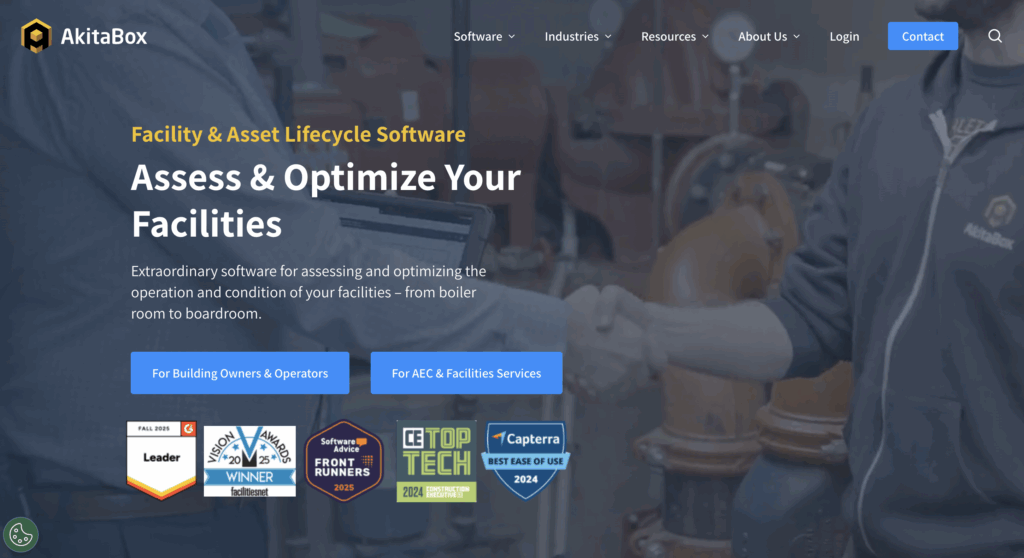
AkitaBox is a facility and asset management software. It offers tools for managing maintenance, inspections, budgeting, and building data.
Why I chose AkitaBox: I chose AkitaBox for its data-focused, floor-plan based approach to facility management.
Asset mapping and work orders
AkitaBox is built around a visual floor plan. That means that every asset is pinned to its exact location in the building. I liked that this gives facility teams instant context. When you click on a pin, you get all of the asset’s details, including specs, warranty info, documents, maintenance history, and more. I can see this helping new team members find equipment much faster, especially if you manage a large or complex facility. The map is interactive, so you can zoom in and out, filter by asset type, and quickly navigate between areas in the building.
This visual framework carries into maintenance, which I liked a lot. Worker orders are tied to locations on the floor plan, so technicians know exactly where to go. You can create, assign, and track tasks from start to finish, and complete checklists for consistent work. The platform lets you schedule preventive maintenance by time intervals or industry standards, and it generates work orders automatically when tasks are due.
There’s also occupant messaging, which basically sends automatic updates to anyone who submits a request.
Data collection and reporting
The AkitaBox Capture app makes it easy to collect data in the field. Facility teams can pin assets on floor plans, add photos, record conditions, and update details as they walk through the building. I also liked that technicians can complete work orders, scan QR codes, and look up documents directly from their mobile devices or tablets. Everything syncs automatically, which means that the digital floor accurately reflects facility changes.
Once the data is recorded, AkitaBox turns it into clear, useful dashboards. You can view key metrics like work order completion rates, response times, and costs. Reports are updated in real-time, which I appreciated.
Modular tools and add-ons
AkitaBox is designed as a modular suite; the core platform handles maintenance and asset tracking, but you can add more tools as you need them. For example, AkitaBox Inspections helps teams manage compliance and safety checks with custom forms and digital audit trails. AkitaBox Connect is geared toward construction handover.
This modular setup lets facility teams build the system they need, but it also means that some features that come standard on other platforms are paid add-ons. I think this is AkitaBox’s biggest drawback. It’s an innovative software, but you likely need extra modules on top of an already unlisted price. For teams looking for a simple facility management software, this might feel complex and get expensive pretty fast.
Key Features
- Asset mapping
- Work orders
- Reporting
- Preventive maintenance
Pros
- Innovative floor plan interface
- Strong data collection
Cons
- Complex and costly modular setup
- Quote-based pricing model
Pricing
Contact vendor for price Trial: No Free Plan: No
Compare the Best Facility Management Software Tools
| Topic |
 Start for free
Start for free
|

|

|

|

|

|
|---|---|---|---|---|---|---|
| Reviews |
4.8
|
4.6
|
4.7
|
4.4
|
4.9
|
N/A
|
| Pricing |
Starts at just $29/month for the first 30 users
|
Starts at $20 per month per user
|
Contact vendor for price
|
Starts at $69/month
|
Contact vendor for price
|
Contact vendor for price
|
| Free Trial |
yes
14-day
|
yes
7 days
|
no
|
yes
|
yes
30-day
|
no
|
| Free Plan |
yes
Free Up to 10 users
|
no
|
no
|
no
|
yes
No
|
no
|
| Use cases |
Best all-in-one Facility Management Software
|
Good for mobile-first work order and asset management
|
Good for facilities, maintenance, and scheduling across multiple sites
|
Good for asset tracking and maintenance history
|
Good for balancing usability and powerful maintenance tools
|
Good for integrated facility condition and asset data visualization
|
| Available on |
Web
|
Web, iOS, Android
|
Web, iOS, Android, Windows, Mac
|
What is Facility Management Software?
Facility management software is a digital tool that helps organizations run their buildings, equipment, and assets in an efficient way. These platforms act as a central hub where teams can manage work orders, schedule maintenance, track assets, and respond to requests.
Organizations of all sizes use this software to keep their buildings safe, functional, and operating smoothly. It supports everything from routine upkeep and equipment repairs to vendor coordination and staff schedules. Ultimately, facility management software gives teams a structured system to simplify complex logistics and helps them stay ahead of issues before they become costly problems.
How does Facility Management Software Work?
Facility management software works by centralizing all of the moving parts of a building’s operations into a unified system. It lets teams create and assign work orders for maintenance or repairs, log issues, and track progress. Most platforms let you schedule routine maintenance, store asset information, manage inventory, and keep important documents in one place, like manuals and SOPs.
Teams can usually access the software on their mobile devices, which allows them to track tasks, add photos, and update details from the field. Some tools offer dashboards and reporting to give managers insight into progress, delays, and equipment performance over time. When everything is connected, facility teams can operate more efficiently and solve problems faster.
The Benefits of Facility Management Software
There are multiple ways facility management software can help your team, including:
Improved efficiency
It’s easy to lose track of work orders and requests when they’re scattered across emails, texts, and casual conversations. Facility management software clears the clutter, bringing all requests into one system. This means your team can spend less time looking for information and more time solving problems before they grow.
Increased visibility
When you manage a facility, whether it’s one building or a whole campus, it can be hard to know what’s going on. Facility management software gives managers real-time visibility by centralizing open tasks, ongoing projects, and upcoming maintenance. This clarity helps managers take charge, prevent bottlenecks, and reduce downtime to keep daily operations
Better upkeep
If you don’t have a reliable system, preventive maintenance can easily become reactive. The right software helps teams plan ahead by scheduling recurring tasks and tracking asset history. The result? Fewer unexpected breakdowns, longer equipment life, and steadier operating costs.
Stronger collaboration
Facility work usually involves multiple people, vendors, and departments. Software helps align everyone, ensuring that everyone has the same information. With clearer communication, you can reduce misunderstandings, improve coordination, and keep projects moving without excessive follow-up.
Smarter decisions
Great facility management software converts daily activity into actionable data. Managers can view response times, when and where delays happen, and how resources are used. These insights help you budget more accurately, plan for the future, and justify upgrades with proven numbers, not guesswork.
Happier occupants
When your team stays organized and fixes problems quickly, people notice. Employees, tenants, and guests enjoy a safer, cleaner, more reliable space. Your team also benefits, dealing with less stress, fewer surprises, and a much more manageable workday.
How Much Does Facilities Management Software Cost?
Facility management software ranges in price depending on the features you need and your team size. Most platforms offer per-user pricing, with lower-tier plans starting between $20 per user per month and $69 per user per month. Even if you have a small facilities team, these costs can quickly add up.
Connecteam stands out for its inclusive pricing and Small Business Plan, which is completely free for up to 10 users. Connecteam’s paid plans start at $29 per month and cover up to 30 users. Higher-tier plans start at $49/month for Advanced and $99/month for Expert, both also including up to 30 users.
FAQs
The main difference between facility management software and CMMS is the scope. CMMS focuses on maintenance tasks like work orders and repairs, while facility management software extends to space planning, vendor management, and asset tracking across the entire facility.
Large office buildings, hospitals, schools, warehouses, and multi-site organizations benefit most from facility management software. These businesses rely on functional space use, maintenance tracking, and asset control, which facility software centralizes and automates for better performance.
Key KPIs to track in facility management software include work order completion time, preventive maintenance rates, asset uptime, space usage, and energy efficiency. These metrics help you understand operational performance, identify inefficiencies, and improve cost control.
Facility management software helps with budgeting and cost control by tracking maintenance expenses, forecasting future needs, and identifying cost-saving opportunities. With greater data visibility, you can reduce waste, prevent equipment failures, and optimize resource allocation.
In the long-term, facility management software strengthens asset management by extending equipment life, reducing downtime, lowering repair costs, and helping you plan better for replacements. With reliable data, you can improve asset performance and protect your investments.
The Bottom Line on Facility Management Software
Managing a facility involves a lot of moving parts. If you’re not careful, things can get messy quickly. Work orders disappear, equipment breaks down unexpectedly, and teams rush to react instead of planning ahead.
Facility management software puts the tools you need in one place, helping you stay organized, respond faster, and keep operations moving. The right platform helps you schedule maintenance, track tasks, manage assets, and communicate clearly. It gives your team the structure to work confidently and effectively.
Connecteam stands out as the best option. It brings operations, communication, and employee management together in a simple, mobile-first system that everyone can use. For teams that want a smoother day-to-day, Connecteam is the clear choice.
See why Connecteam is facility managers’ favorite tool—start free today!


